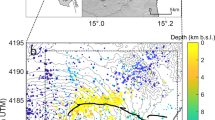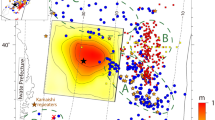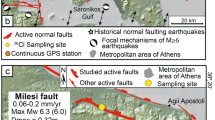Abstract
Intraplate earthquakes on a fault in Earth’s upper crust commonly recur in 1,000 years or longer. The 2011 M9 Tohoku-Oki earthquake triggered the activation of intraplate earthquakes in northern Kanto, Japan, including two M6 events on 19 March 2011 and 28 December 2016 located near one another. Here we use displacements captured by satellite radar and the Global Navigation Satellite System to show that the two earthquakes ruptured an identical fault. Detailed fault slip modelling shows that the deformation data for the two earthquakes are well explained by slip along a common fault geometry, and that the majority of the slipped area on the fault overlaps. Strain analysis reveals that the first M6 earthquake was followed by exceptionally large postseismic deformation. Such deformation is consistent with afterslip around the M6 rupture area, which in turn rebuilds the shear stress on the fault enabling the next earthquake. We infer that the rapid and large postseismic deformation of the 2011 Tohoku-Oki earthquake promoted such afterslip and made the second earthquake recur in just 5.8 years. This study suggests a mechanism to explain observations of extreme temporal clustering in palaeoseismic earthquake recurrence studies.
This is a preview of subscription content, access via your institution
Access options
Access Nature and 54 other Nature Portfolio journals
Get Nature+, our best-value online-access subscription
$29.99 / 30 days
cancel any time
Subscribe to this journal
Receive 12 print issues and online access
$259.00 per year
only $21.58 per issue
Buy this article
- Purchase on Springer Link
- Instant access to full article PDF
Prices may be subject to local taxes which are calculated during checkout




Similar content being viewed by others
References
Okada, T. et al. Shallow inland earthquakes in NE Japan possibly triggered by the 2011 off the Pacific coast of Tohoku earthquake. Earth Planets Space 63, 749–754 (2011).
Toda, S., Stein, R. S. & Lin, J. Widespread seismicity excitation throughout central Japan following the 2011 M = 9.0 Tohoku earthquake and its interpretation by Coulomb stress transfer. Geophys. Res. Lett. 38, L00G03 (2011).
Imanishi, K., Ando, R. & Kuwahara, Y. Unusual shallow normal-faulting earthquake sequence in compressional northeast Japan activated after the 2011 off the Pacific coast of Tohoku earthquake. Geophys. Res. Lett. 39, L09306 (2012).
Kato, A., Sakai, S. & Obara, K. A normal-faulting seismic sequence triggered by the 2011 off the Pacific coast of Tohoku earthquake: wholesale stress regime changes in the upper plate. Earth Planets Space 63, 745–748 (2011).
Fukushima, Y., Takada, Y. & Hashimoto, M. Complex ruptures of the 11 April 2011 M w 6.6 Iwaki earthquake triggered by the 11 March 2011 M w 9.0 Tohoku earthquake, Japan. Bull. Seismol. Soc. Am. 103, 1572–1583 (2013).
Kobayashi, T. et al. InSAR-derived crustal deformation and fault models of normal faulting earthquake (M j 7.0) in the Fukushima-Hamadori area. Earth Planets Space 64, 1209–1221 (2012).
Tanaka, M., Asano, K., Iwata, T. & Kubo, H. Source rupture process of the 2011 Fukushima-ken Hamadori earthquake: how did the two subparallel faults rupture? Earth Planets Space https://doi.org/10.1186/1880-5981-66-101 (2014).
Toda, S. & Tsutsumi, H. Simultaneous reactivation of two, subparallel, inland normal faults during the M w 6.6 11 April 2011 Iwaki earthquake triggered by the M w 9.0 Tohoku-Oki, Japan, earthquake. Bull. Seismol. Soc. Am. 103, 1584–1602 (2013).
Kobayashi, T. et al. Crustal deformation map for the 2011 off the Pacific coast of Tohoku earthquake, detected by InSAR analysis combined with GEONET data. Earth Planets Space 63, 621–625 (2011).
Aoyagi, Y. Surface rupture of the recent moderate earthquakes detected by DInSAR. In 94th Report of the Coordinating Committee for Earthquake Prediction, Japan [In Japanese] abstr. 12-6 (2015); http://cais.gsi.go.jp/YOCHIREN/activity/206/image206/017.pdf
Omuralieva, A. M., Hasegawa, A., Matsuzawa, T., Nakajima, J. & Okada, T. Lateral variation of the cutoff depth of shallow earthquakes beneath the Japan Islands and its implications for seismogenesis. Tectonophysics 518, 93–105 (2012).
Berryman, K. R. et al. Major earthquakes occur regularly on an isolated plate boundary fault. Science 336, 1690–1693 (2012).
Freed, A. M. et al. Resolving depth-dependent subduction zone viscosity and afterslip from postseismic displacements following the 2011 Tohoku-Oki, Japan earthquake. Earth Planet. Sci. Lett. 459, 279–290 (2017).
Iinuma, T. et al. Seafloor observations indicate spatial separation of coseismic and postseismic slips in the 2011 Tohoku earthquake. Nat. Commun. 7, 13506 (2016).
Diao, F. Q. et al. Overlapping post-seismic deformation processes: afterslip and viscoelastic relaxation following the 2011 M w 9.0 Tohoku (Japan) earthquake. Geophys. J. Int. 196, 218–229 (2014).
Suito, H. Importance of rheological heterogeneity for interpreting viscoelastic relaxation caused by the 2011 Tohoku-Oki earthquake. Earth Planets Space https://doi.org/10.1186/s40623-017-0611-9 (2017).
Linker, M. F. & Dieterich, J. H. Effects of variable normal stress on rock friction—observations and constitutive-equations. J. Geophys. Res. Solid Earth 97, 4923–4940 (1992).
Wasteby, N. et al. Hydrochemical monitoring, petrological observation, and geochemical modeling of fault healing after an earthquake. J. Geophys. Res. Solid Earth 119, 5727–5740 (2014).
Vidale, J. E. & Li, Y. G. Damage to the shallow Landers fault from the nearby Hector Mine earthquake. Nature 421, 524–526 (2003).
Reid, H. F. The Mechanics of the Earthquake, The California Earthquake of April 18, 1906 Report of the State Investigation Commission Vol. 2 (Carnegie Institution of Washington, 1910).
Gilbert, G. K. A theory of the earthquakes of the Great Basin with a practical application. Am. J. Sci. 27, 49–53 (1884).
Hashimoto, M. et al. Postseismic displacements following the 2007 Noto Peninsula earthquake detected by dense GPS observation. Earth Planets Space 60, 139–144 (2008).
Iinuma, T. et al. Postseismic slip associated with the 2007 Chuetsu-oki, Niigata, Japan, earthquake (M 6.8 on 16 July 2007) as inferred from GPS data. Earth Planets Space 60, 1087–1091 (2008).
Nakano, T. & Hirahara, K. GPS observations of postseismic deformation for the 1995 Hyogo-ken Nanbu earthquake, Japan. Geophys. Res. Lett. 24, 503–506 (1997).
Ohta, Y. et al. Coseismic and postseismic deformation related to the 2007 Chuetsu-oki, Niigata earthquake. Earth Planets Space 60, 1081–1086 (2008).
Ohzono, M., Ohta, Y., Iinuma, T., Miura, S. & Muto, J. Geodetic evidence of viscoelastic relaxation after the 2008 Iwate-Miyagi Nairiku earthquake. Earth Planets Space 64, 759–764 (2012).
Yagi, Y. & Fukahata, Y. Rupture process of the 2011 Tohoku-Oki earthquake and absolute elastic strain release. Geophys. Res. Lett. 38, L19307 (2011).
Research Group for Active Faults in Japan Active Faults in Japan, Sheet Maps and Inventories revised edn (Univ. Tokyo Press, Tokyo, 1991).
Ozawa, T., Fujita, E. & Ueda, H. Crustal deformation associated with the 2016 Kumamoto earthquake and its effect on the magma system of Aso Volcano. Earth Planets Space https://doi.org/10.1186/s40623-016-0563-5 (2016).
Shimada, M. Verification processor for SAR calibration and interferometry. Adv. Space Res. 23, 1477–1486 (1999).
Jarvis, A., Reuter, H. I., Nelson, A. & Guevara, E. Hole-filled SRTM Data V4 (2008); http://srtm.csi.cgiar.org (accessed on 5 December 2017)
Farr, T. G. et al. The shuttle radar topography mission. Rev. Geophys. 45, RG2004 (2007).
Baran, I., Stewart, M. P., Kampes, B. M., Perski, Z. & Lilly, P. A modification to the Goldstein radar interferogram filter. IEEE Trans. Geosci. Remote Sens. 41, 2114–2118 (2003).
Chen, C. W. & Zebker, H. A. Network approaches to two-dimensional phase unwrapping: intractability and two new algorithms. J. Opt. Soc. Am. A 17, 401–414 (2000).
Beauducel, F., Briole, P. & Froger, J. L. Volcano-wide fringes in ERS synthetic aperture radar interferograms of Etna (1992–1998): Deformation or tropospheric effect? J. Geophys. Res. Solid Earth 105, 16391–16402 (2000).
Onn, F. & Zebker, H. A. Correction for interferometric synthetic aperture radar atmospheric phase artifacts using time series of zenith wet delay observations from a GPS network. J. Geophys. Res. Solid Earth 111, B09102 (2006).
Fukushima, Y., Cayol, V. & Durand, P. Finding realistic dike models from interferometric synthetic aperture radar data: the February 2000 eruption at Piton de la Fournaise. J. Geophys. Res. Solid Earth 110, B03206 (2005).
Fukushima, Y., Mori, J., Hashimoto, M. & Kano, Y. Subsidence associated with the LUSI mud eruption, East Java, investigated by SAR interferometry. Mar. Petrol. Geol. 26, 1740–1750 (2009).
Fukuda, J. & Johnson, K. M. A fully Bayesian inversion for spatial distribution of fault slip with objective smoothing. Bull. Seismol. Soc. Am. 98, 1128–1146 (2008).
Thomas, A. L. Poly3D: A Three-dimensional, Polygonal Element, Displacement Discontinuity Boundary Element Computer Program with Applications to Fractures, Faults, and Cavities in the Earth’s Crust. MS thesis, Stanford Univ. (1993).
Maerten, F., Resor, P., Pollard, D. & Maerten, L. Inverting for slip on three-dimensional fault surfaces using angular dislocations. Bull. Seismol. Soc. Am. 95, 1654–1665 (2005).
Eberhart, R. C. & Kennedy, J. A new optimizer using particle swarm theory. In Proc. Sixth International Symposium on Micromachine and Human Science, Nagoya, Japan 39–43 (IEEE, New York, 1995).
Fukuda, J. & Johnson, K. M. Mixed linear-non-linear inversion of crustal deformation data: Bayesian inference of model, weighting and regularization parameters. Geophys. J. Int. 181, 1441–1458 (2010).
Demets, C., Gordon, R. G., Argus, D. F. & Stein, S. Effect of recent revisions to the geomagnetic reversal time-scale on estimates of current plate motions. Geophys. Res. Lett. 21, 2191–2194 (1994).
Acknowledgements
We used the PALSAR data shared among the PALSAR Interferometry Consortium to Study our Evolving Land Surface (PIXEL). The data were provided by the Japan Aerospace Exploration Agency (JAXA) under a cooperative research contract with the Earthquake Research Institute of the University of Tokyo. We used the PALSAR-2 data provided from JAXA through the Earthquake Working Group, a project for evaluating ALOS for disaster mitigation, coordinated by the Geospatial Information Authority of Japan (GSI) and JAXA. The GEONET GNSS data were provided by GSI. We are grateful to the developers of the InSAR and SAR processors used in this study: T. Ozawa of the National Research Institute for Earth Science and Disaster Resilience of Japan, and M. Shimada of Tokyo Denki University. We also thank M. Ohata for helping our field survey. We are also grateful to T. Iinuma for providing models of coseismic slip and afterslip of the Tohoku-Oki earthquake. This study was partially supported by the Japan Society for the Promotion of Sciences KAKENHI Grant Number JP18K03795.
Author information
Authors and Affiliations
Contributions
Y.F. analysed the SAR images, performed fault slip inversions and led the preparation of the paper. D.I. and S.T. investigated the surface ruptures with an emphasis on comparison with on-site surveys. S.M., T.D. and K.T. planned and operated the GNSS measurements in the target region since 2014. S.M. processed the GNSS data. Y.F., S.T. and J.F. performed the stress change calculations, and J.F. computed the stress-driven afterslip.
Corresponding author
Ethics declarations
Competing interests
The authors declare no competing interests.
Additional information
Publisher’s note: Springer Nature remains neutral with regard to jurisdictional claims in published maps and institutional affiliations.
Supplementary information
Supplementary Information
Supplementary Figures and Tables
Rights and permissions
About this article
Cite this article
Fukushima, Y., Toda, S., Miura, S. et al. Extremely early recurrence of intraplate fault rupture following the Tohoku-Oki earthquake. Nature Geosci 11, 777–781 (2018). https://doi.org/10.1038/s41561-018-0201-x
Received:
Accepted:
Published:
Issue Date:
DOI: https://doi.org/10.1038/s41561-018-0201-x
This article is cited by
-
Distinct rupture processes on a fault where M6-class earthquakes reoccurred in a short period: analysis of the 2011 and 2016 Northern Ibaraki, Japan, earthquakes using near-field waveforms
Earth, Planets and Space (2023)
-
Repeated triggered ruptures on a distributed secondary fault system: an example from the 2016 Kumamoto earthquake, southwest Japan
Earth, Planets and Space (2021)
-
Characteristics of secondary-ruptured faults in the Aso Caldera triggered by the 2016 Mw 7.0 Kumamoto earthquake
Earth, Planets and Space (2020)
-
Surface rupture and characteristics of a fault associated with the 2011 and 2016 earthquakes in the southern Abukuma Mountains, northeastern Japan, triggered by the Tohoku-Oki earthquake
Earth, Planets and Space (2019)



